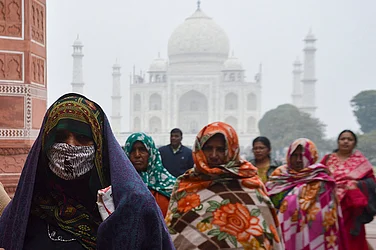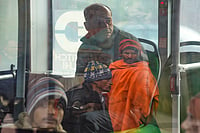Residents of Begum in Kashmir’s Kulgam district, around 85 km south of summer capital Srinagar, were used to the sight of 28-year-old Rayees Ahmad Wani loitering around the village. They say he had never crossed the village boundary until November 3—the fateful day when he stepped out for the first time, and ended up taking two bullets in his head and two in his chest, 30 km away from the village, in the neighbouring Shopian district. “We want to know how he was killed,” says Mushtaq Ahmad Wani, a relative and neighbour. “It was raining heavily that night, but when we received his bullet-riddled body the next day, his clothes and footwear were not wet.”
It was early in the morning on November 4 that the police informed the family about his death. According to the police, at around 3 am, Rayees tried to walk into the camp of 44 Rashtriya Rifles of the Indian army stationed at Pahnoo village in Shopian district. He was shot when he allegedly didn’t heed the warning shots fired in the air by soldiers manning a bunker. But could Rayees, known to be mentally challenged, have walked 30 km that night, crossing over to another district? His shocked kin and other villagers suspect it was a case of custodial killing.
When Rayees didn’t return home after sunset on November 3, his father Abdul Hameed Wani, 62, had started searching for him. Other villagers joined him and an announcement was made from the loudspeaker of the mosque. Some also took to Facebook and sought help in locating him. “I can never forget that night,” says Hameed, breaking down. “The whole night I was worried that he could die due to the severe cold outside. I never imagined he would be shot dead. They could have fired at his legs to stop him, but they killed him.” His kangri, a Kashmiri firepot that keeps people warm during the winter months in the Valley, was by his side when he was fired upon, claim Rayees’s family members.
Rayees means “the rich one”. The only male among six siblings, his father had realised early that he was not like the other boys of the village. Instead of getting him enrolled in the village school, he got Rayees to help him with agriculture work in the fields. Doctors claim Rayees could have been suffering from schizophrenia as “aimless wandering is more common among such patients”.
Rayees is not the first Kashmiri killed by government forces for wandering close to military installations. Since the armed insurgency erupted in the Valley, a number of persons suffering from psychiatric disorders have been killed in this manner. According to the Jammu and Kashmir Coalition of Civil Society (JKCCS), a Srinagar-based human rights organisation, there are 18 documented cases of mentally challenged people killed by government forces since 2003.
On January 6, 2009, soon after Omar Abdullah had taken over as CM of Jammu and Kashmir, the army shot dead Abdul Rashid Reshi on the high-security Gupkar Road in Srinagar, claiming he had crossed the main gate of the 31 Sub-Area Commander’s residence. Then, on January 5, 2011, an unidentified, mentally challenged man was shot dead in Lolab, Kupwara, late in the evening after he “didn’t stop despite repeated warnings”, according to the police.
There are also cases in which the army detained mentally challenged persons caught loitering and handed them over to the police. For instance, Om Prakash, who has been an inmate at the Government Psychiatric Diseases Hospital, Srinagar, since 2012, was detained by the army in July that year while trying to enter the Air Force Station in Srinagar. The army handed him over to the police, who sent him to the hospital after questioning. During examination, doctors found that he hailed from Rajouri district of Jammu, and that the locals of Budgam, who used to feed him, knew him as Rahim Bakerwal. For the past seven years, his doctors at the hospital have been writing to the authorities that he should be handed over to his family or rehabilitated in his community, but the government is yet to respond.
There is also an unknown female patient in the hospital since January 14, 2017, who is believed to be from Pakistan-occupied Kashmir. She was found wandering in Uri area along the Line of Control in north Kashmir near a security installation. As her speech is incomprehensible, the doctors have been unable to locate her family. The police had handed over both Om Prakash and the unknown woman to the hospital as they were not locals. In case of locals like Rayees, it is their family and community that are expected to take care of them.
Maroof Shah, who writes on Sufi traditions, says these “wanderers” have had a special place in Kashmiri society. “They have been seen as guests of God, to be honoured in society,” he says. “In Kashmir, they are understood to be specially abled, having mystic powers, unlike in industrialised societies where they are put in mental asylums. Some hardline Salafis are also arguing that they should be put in asylums, but I don’t think Kashmiri society would like that.”
Doctors at the psychiatric hospital in Srinagar recount a curious anecdote. When Sir Walter Lawrence, who was appointed as the settlement commissioner for Jammu and Kashmir during 1889-94, visited the mental asylum in Srinagar, he was surprised to find no Kashmiri Muslim among the inmates, though there were 48 Pandits. Lawrence thought insanity was not prevalent among Kashmiri Muslims. Later, when he visited village after village, he found them in hundreds, but saw that they were taken care of by their families and the villagers—in his words, just like the “imbeciles of Switzerland”. Even at present, the doctors say, one per cent of the population in Kashmir suffers from schizophrenia and they are all taken care of in their families.
Over the centuries, it’s been usual for such people to wander around, with the people ensuring their safety and security wherever they went. It was the militarisation accompanying the armed insurgency since the 1990s that put severe restrictions on their free movement. As doctors put it, everywhere else in the world, bad weather is the main threat faced by wanderers, but the bullet has taken that place in Kashmir.
Dr Arshad Hussain, professor of psychiatry at the Government Medical College, Srinagar, points out that people with mental disorders such as schizophrenia become especially vulnerable to violence in zones of conflict. “That’s mainly because of their tendency to wander, though nothing can exonerate the killing of an innocent person. Homeless people with mental disorders exist even in countries with the best mental healthcare facilities such as the US. But we are especially vulnerable because of being in the midst of a conflict, and we are paying price for it. Most such cases are as cruel and heart-wrenching as Rayees’s. We must not make a norm of accepting the killings of people with mental disorders as collateral damage of the conflict. ”
- There are 18 documented cases of mentally challenged people killed by government forces since 2003, as per JKCCS.
- Sometimes the army detains mentally challenged persons caught loitering and hands them over to the police.
- “Wanderers have been seen as guests of God, specially abled...here they aren’t put in asylums,” says Maroof Shah, Sufism expert.
By Naseer Ganai in Kulgam


























